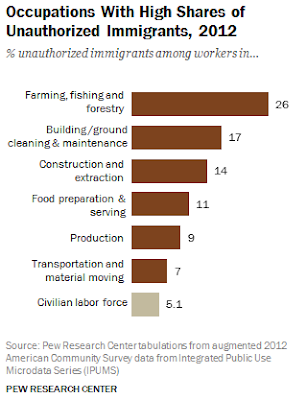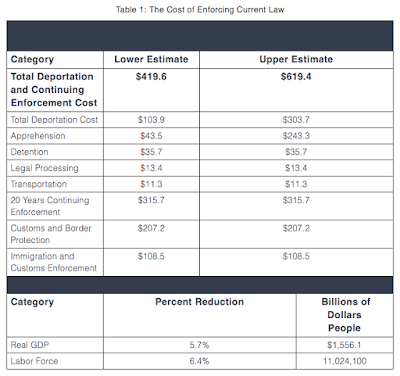With immigration and immigration reform forming a hot button issue during the 2016 presidential election cycle, an analysis by the American Action Forum (AAF) looks at the budgetary and economic costs that addressing illegal immigration would place on the U.S. economy. With an estimated 11.2 million undocumented immigrants currently living in the United States, as you will see, the costs are extremely high. We will divide this posting into two parts; first looking at the budgetary cost to taxpayers associated with the enforcement of current immigration laws and then look at the costs to the economy should undocumented immigrants be deported. Please note that all cost estimates are in 2013 dollars; the impact of inflation on these costs will push them significantly higher over the 20 year period necessary to implement the enforcement of current immigration laws.
1.) The Budgetary Cost of Enforcing Current Immigration Laws: As I noted above, according to Pew, there are approximately 11.2 million undocumented immigrants living in the United States, making up 3.5 percent of the U.S. population and 26 percent of foreign-born Americans. About 66 percent of these undocumented immigrants have lived in the United States for at least 10 years and almost half were parents of minor children as shown here:
In 2012, 6.9 percent of all pre-college aged students had at least one undocumented immigrant parent. On the employment front, as many as 8.1 million of these undocumented immigrants or 5.1 percent of the total labour force were either working or looking for work in 2012.
Many Americans, politicians and aspiring politicians among them, unequivocally state that the United States needs to fully enforce current immigration law which would ultimately lead to the deportation of all 11.2 million undocumented immigrants. Assuming that 20 percent would leave the United States on a voluntary basis, the remaining 80 percent would have to be forcibly removed. To help us better understand the budgetary costs of such enforcement, AAF has made two key assumptions:
a.) As I noted above, 20 percent would leave voluntarily including the 15 percent of undocumented adult immigrants who have been in the United States for less than 5 years. This would leave approximately 8.96 million immigrants who would have to be forcibly deported.
b.) The Department of Homeland Security's Immigration and Customs Enforcement (ICE) is the federal agency with the primary responsibility of deporting illegal immigrants. In 2013, ICE deported 330,651 unlawful immigrants and Ice has stated that it currently only has the capacity to remove a maximum of 400,000 immigrants on an annual basis. This means that it would take nearly 20 years to deport all 8.96 million remaining undocumented immigrants, a situation that would change should funding levels increase substantially.
There are four stages necessary to enforce current immigration law. Here is a summary of each stage and its associated costs:
a.) Apprehension costs: These included the costs of criminal arrests where ICE agents pursue and arrest undocumented immigrants as well as the cost of administrative arrests where undocumented immigrants are arrested based on another violation (i.e. a traffic violation) after which ICE agents are contacted. In fiscal 2013, administrative arrests accounted for the vast majority of the total arrests made by ICE, totalling 241,694 out of the 330,651. Based on the high percentage of less expensive (to ICE) cost of administrative arrests, on average, in 2013, ICE's apprehension costs averaged $4,856 per arrest. In 2013, ICE used its own investigators and Fugitive Operations Teams to arrest a further 43,218 immigrants at an average cost of $27,155 per immigrant. Using these figures, AAF concludes that:
– ICE would need $43.5 billion to make a majority of the 8.96 million arrests administratively.
– ICE would need $243.3 billion to make a majority of the 896 million arrests criminally.
b.) Detention costs: ICE is required to detain undocumented immigrants until their fate is determined by a judge. In fiscal 2013, ICE had 34,000 bed spaces and immigrants were detained by ICE for an average of 33.5 days prior to their court date. It cost ICE an average of $118.88 per day to detain a single undocumented immigrant; carrying this forward, it would cost about $35.7 billion to detain all 8.96 million undocumented immigrants over the next 20 years.
c.) Legal costs: Once ICE detains undocumented immigrants, it must legally process them. It costs the Justice Department's Executive Office of Immigration Review an average of $1,495 to legally process each undocumented immigrant in 2013; as a result, it would cost $13.4 billion to legally process all 8.96 million undocumented immigrants.
d.) Transportation costs: Once undocumented immigrants have been apprehended, detained and legally processed, ICE must transport them back to their country of origin. In 2012, 52.4 percent were from Mexico, 15.2 percent were from Central America, 12.4 percent were from Asia and 6.3 percent were from South America. In 2013, 9.6 percent of departing undocumented immigrants left on their own without any financial assistance from ICE. This would leave about 8.1 million undocumented immigrants that would require transportation; using the 2013 average of $1,400, it would cost $11.3 billion to transport 8.1 million undocumented immigrants.
If we sum up the costs for each stage of enforcement, it would cost U.S. taxpayers between $103.9 and $303.7 billion to remove 8.96 million undocumented immigrants.
That's not all. In order to keep future undocumented immigrants from entering the United States while the system is trying to deport those currently living in America, increased enforcement would be required. AAF estimates that to budgets for both ICE and the Customs and Border Protection would have to rise from their total of $15.8 billion in fiscal 2013, however, just using the 2013 budgetary numbers, the federal government would have to spend $316 billion over the next 20 years to keep new undocumented immigrants from crossing the American border.
2.) The Economic Costs of Enforcing Current Immigration Laws:
As I noted above, about 5.1 percent of the U.S. workforce is undocumented immigrants. In some industries, they form a substantial portion of overall workers as shown on this graphic from Pew:
By removing all undocumented immigrants, the total size of the labor force would shrink by 11 million workers by 2034. As a result, over the first ten years, average economic growth would shrink by 0.5 percent annually and, in 20 years, the economy would be 5.7 percent smaller than it would have been had the government not removed all undocumented workers. This suggests that real GDP in 2034 would be $1.6 trillion lower than the Congressional Budget Office's (CBO) baseline estimates. On top of the shrinking GDP, removing undocumented immigrants would have a negative impact on federal tax revenues. Estimates from the CBO and the Social Security Administration show that 50 percent of undocumented immigrants pay federal taxes and are not users of social services meaning that their departure would result in a let loss of federal revenue. The Bipartisan Policy Center calculates that removing all undocumented immigrants would result in a deficit increase of $800 billion over the next 20 years.
To summarize, here is a table showing the total costs of enforcing America's current immigration laws:
Obviously, from a cost standpoint, the ongoing debate about undocumented immigrants in the United States is far from clear cut. The costs to taxpayers and the negative impact on the economy and the federal budgetary balance are substantial and would suggest that decision-makers need to carefully consider all of the repercussions of implementing a harsher immigration climate in the United States.
Click HERE to read more of Glen Asher's columns
You can publish this article on your website as long as you provide a link back to this page.




Be the first to comment